Auto logout in seconds.
Continue LogoutCMS has released proposed rules for the Medicare Physician Fee Schedule (MPFS), Outpatient Prospective Payment System (OPPS), and ambulatory surgical centers (ASCs) for calendar year (CY) 2026.
Inside the proposed MPFS rule
For CY 2026, CMS has proposed two separate conversion factors: one for participants in qualifying alternative payment models (APMs) and one for those in nonqualifying APMs.
For qualifying APMs, CMS proposed a conversion factor of $33.59, an increase of $1.24 or 3.83% from the current conversion factor of $32.35. For nonqualifying APMs, the agency proposed a conversion factor of $33.42, an increase of $1.07 or 3.3% from the current conversion factor.
The conversion factors include a 0.75% update for qualifying APMs and 0.25% for nonqualifying APMs, a one-year 2.5% increase as required by the One Big Beautiful Bill Act, and an estimated 0.55% increase to account for account for proposed changes in some work relative value units.
Aside from the payment updates, CMS also proposed limiting how long certain participants in the Medicare Shared Savings Program can stay in one-sided risk arrangements. This change aims to increase participation in two-sided risk arrangements.
Currently, accountable care organizations (ACOs) in the Shared Savings Program are required to cover at least 5,000 Medicare beneficiaries, something ACOs have said limits their participation in the program. To ease the burden on ACOs, CMS proposed increasing the time they have to achieve this benchmark to three years beginning in 2027.
CMS also proposed a five-year mandatory payment model called the Ambulatory Specialty model, which would begin in 2027. The new payment model would require specialists to improve care for heart failure and lower back pain.
The proposed rule includes provisions that would enhance telehealth flexibilities, including a simplified process for making more telehealth services reimbursable under Medicare and allowing physicians to carry out direct supervision for certain services virtually.
"We are taking meaningful steps to modernize Medicare, cut waste, and improve patient care," said CMS Administrator Dr. Mehmet Oz. "We're making it easier for seniors to access preventive services, incentivizing health care providers to deliver real results, and cracking down on abuse that drives up costs. This is how we protect Medicare for the next generation while helping Americans live longer, healthier lives."
Inside the proposed OPPS/ASC rule
In the OPPS/ASC proposed rule, CMS said it would increase payments to outpatient healthcare facilities and ASCs by 2.4% in CY 2026. The payment update includes a hospital market basket percentage increase of 3.2%, along with a -0.8 percentage point productivity adjustment. This payment update is slightly smaller than the 2.9% increase for 2025.
Aside from the payment updates, the proposed rule also includes changes to hospital price transparency regulations and provisions for "site-neutral" payments.
Starting Jan. 1, 2026, CMS said it would require hospitals to include detailed ranges of the rates they negotiate with health insurance plans in machine-readable files. These rates are known as "allowed amounts" and would include the 10th, median, and 90th percentile.
CMS also proposed requiring hospitals to attest that they have listed all their negotiated rates in dollars when able, or otherwise include "all necessary information available to the hospital for the public to derive the dollar amount" from their machine-readable files.
Building on a 2019 site-neutral payment policy, CMS proposed that hospitals offering outpatient drug administration be paid the same amount that Medicare reimburses physicians for these services.
The agency also plans to phase out the "inpatient only list," which includes codes that Medicare only reimburses in inpatient settings, over a three-year period beginning in 2026. A set of around 300 musculoskeletal procedure codes would be the first ones eligible for outpatient reimbursement.
"This proposal would allow for these services to be paid by Medicare in the hospital outpatient setting when determined to be clinically appropriate, giving physicians greater flexibility in determining the most appropriate site of service," CMS said.
RELATED resources
- Insights from the 2026 CMS Advance Notice
- 2026 CMS Advance Notice Executive Summary
- Your guide to CMS' 14 value-based payment models
- How federal cost control tactics promote an enduring hybrid payment environment
- CMS' TEAM payment model is here. How should hospitals prepare?
- Transforming Episode Accountability Model (TEAM)
Commentary
In response to the MPFS proposed rule, several healthcare groups said the payment increase for 2026 was "underwhelming."
"Insufficient Medicare payments are exacerbating the financial burden on doctors created by decades of cumulative reimbursement cuts and rising costs -- placing patients at risk and jeopardizing their access to care," said Carol Langford, president of the American College of Rheumatology. "While this proposed rule includes a boost, it is very underwhelming and doesn't come close to correcting the 33% decline in reimbursements for care since 2001."
Separately, the American Academy of Family Physicians (AAFP) noted that most of the payment increase — 2.5% from the recently passed budget bill — will only last one year. "In 2027, practices will face another pay cut and struggle to keep pace with inflation," the organization said. "The AAFP continues to urge Congress to establish an adequate annual inflationary adjustment. It's a necessary step toward ensuring practices can keep up with rising costs and meet patient needs."
Healthcare groups also expressed dissatisfaction with the payment update in the OPPS/ASC proposed rule.
In a statement, Ashley Thompson, SVP of public policy analysis and development at the American Hospital Association, said the organization was disappointed by the "inadequate" payment increase "as many hospitals — especially those in rural and underserved communities — operate under challenging financial pressures."
Thompson also criticized CMS' proposal to expand site-neutral payments and remove the inpatient-only list, saying "both policies fail to account for the real and crucial differences between hospital outpatient departments and other sites of care."
"Not only is reimbursement failing to keep up with the cost of providing care, the proposed policies contained in this rule will further degrade the critical healthcare infrastructure patients rely on," said Soumi Saha, VP of government affairs at Premier. "Transforming healthcare is a must do. However, putting forward policies in isolation does more harm than good. Premier urges the Centers for Medicare & Medicaid Services to engage patients and providers to collectively and holistically design the future of healthcare that is accountable, transparent, saves federal taxpayer dollars – and most importantly, puts the patient first."
(CMS press release, 7/14; CMS MPFS Proposed Rule fact sheet, 7/14; CMS Medicare Shared Savings Program Proposals fact sheet, 7/14; AHA News, 7/14; Minemyer, Fierce Healthcare, 7/14; Goldman, Axios, 7/15; Early, Modern Healthcare, 7/14; Frieden, MedPage Today, 7/15; CMS OPPS/ASC Proposed Rule fact sheet, 7/15; Early, Modern Healthcare, 7/15; Muoio, Fierce Healthcare, 7/15; AHA News, 7/15; Hagland, Healthcare Innovation, 7/15)
Don't miss out on the latest Advisory Board insights
Create your free account to access 1 resource, including the latest research and webinars.
Want access without creating an account?
You have 1 free members-only resource remaining this month.
1 free members-only resources remaining
1 free members-only resources remaining
You've reached your limit of free insights
Become a member to access all of Advisory Board's resources, events, and experts
Never miss out on the latest innovative health care content tailored to you.
Benefits include:
You've reached your limit of free insights
Become a member to access all of Advisory Board's resources, events, and experts
Never miss out on the latest innovative health care content tailored to you.
Benefits include:
This content is available through your Curated Research partnership with Advisory Board. Click on ‘view this resource’ to read the full piece
Email ask@advisory.com to learn more
Click on ‘Become a Member’ to learn about the benefits of a Full-Access partnership with Advisory Board
Never miss out on the latest innovative health care content tailored to you.
Benefits Include:
This is for members only. Learn more.
Click on ‘Become a Member’ to learn about the benefits of a Full-Access partnership with Advisory Board
Never miss out on the latest innovative health care content tailored to you.



